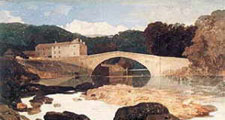Perceptions of the Landscape
Early Accounts
Many of the earliest writings describing the landscapes of County Durham tended to focus on the productivity or otherwise of its agriculture rather than its scenic value. John Leland, the King’s Antiquary, on his extensive travels through England in the mid 16th century described the Bishop of Durham’s deer park as “..rudely enclosed with stone…”
and commented on the fertility of Weardale, noting that “..though the upper part of Weardale be not very fertile of corn, yet is there very fine grass in the dale itself where the river passeth”.
William Cobbett visited the county in 1832, recording in his Rural Rides that Durham was “..a country of pasture and not a country of the plough…”,
and noting “..the absence of homesteads, the absence of barns and of labourers’ cottages…”
in the mixed farmland of the lowland landscapes he passed through.
Scenic Landscapes
Interest in the landscape for its own sake amongst English painters and writers developed from the mid 18th century onwards. The dramatic scenic landscapes of Teesdale and the imposing views of Durham Cathedral and castle attracted many landscape painters including George Lambert, John Sell Cotman and JMW Turner. Some of Cotman’s finest watercolours are of Durham City and the River Greta near Rokeby.
Turner had a long association with Rokeby and stayed there repeatedly to paint some notable images of the dale, including the great waterfalls of High Force and Cauldron Snout, and the ruins of Egglestone Abbey and Barnard Castle. One of his most well known paintings ‘The Meeting of the Waters’ depicts the confluence of the Tees and Greta at Rokeby. His images of Durham Cathedral remain amongst the most powerful and popular of its portrayals.
The reputation of Teesdale as a scenic landscape inspired a spate of Victorian writing about the dales which appealed to the romantic taste for wild moors, dramatic crags and waterfalls. Sir Walter Scott was a regular visitor to the area, which inspired his long poem ‘Rokeby’
“When Denmark’s raven soared on high,
Triumphant through Northumbrian sky,
Till, hovering near, her fatal croak
Bade Reged’s Britons dread the yoke;
And the broad shadow of her wing
Blackened each cataract and spring,
Where Tees in tumult leaves his source,
Thundering o’er Caldron and High Force.
Charles Dickens visited Teesdale in 1832 to carry out research for his novel Nicholas Nickleby and found a great deal of material in the village of Bowes. Dotheby’s Hall, the boy’s school portrayed in the novel, was based on the Bowes Boys Academy.
The Victorian passion for science also meant that the flora of the area attracted attention, as did the geological, social and economic aspects of lead mining. Sir Richard Garland, in describing his guided tour of Teesdale in 1804, writes of the ‘strikingly bold and broken’
scenery, the ‘carpets of gay flowers’
, the ‘boldness and irregularity of the majestic cliffs’
of Cronkley Scar and the ‘awe striking beauty of the temple’
of High Force. Other parts of the county were largely ignored by artists, probably because of the industrial nature of much of the landscape, and particularly the busy ore fields of parts of the North Pennines and the rapidly industrialising coalfield.
The special qualities of the North Pennines, ‘England’s Last Wilderness’
, were given national recognition in 1981 with its designation as an Area of Outstanding Beauty. As biodiversity has become an increasingly important part of the appreciation and understanding of landscape, the designation of large areas of the North Pennines as Special Protection Areas for birds and Special Areas for Conservation under European legislation, or as an international Biosphere Reserve, has underlined its importance. The scenic landscapes of the valleys of the River Wear and its tributaries are now designated as Areas of High Landscape Value in development plans. Durham Castle and Cathedral has been designated as a World Heritage Site by UNESCO.
Industrial Legacies and Landscape Renewal
Mining and industry have had a substantial impact on the character of parts of the Durham landscape and the way it has been perceived. The most abiding images of the County are as an industrial landscape of coal mining, lead mining, steel making and railways, at the heart of the industrial revolution. The industrial landscapes and communities of the coalfield have inspired many local artists and writers. In the mid 20th century painters like Norman Cornish and writers like Sid Chaplin, themselves working miners, captured the unique sense of place and spirit of community in their work.
With the decline of traditional industries perceptions of the landscape have slowly changed. The scars of lead mining and quarrying in the North Pennines have become accepted and valued as part of its cultural heritage. Killhope, The North Of England Lead Mining Museum in upper Weardale is now a popular tourist destination.
The legacies of coal mining have been seen as more problematic, as the widespread dereliction left by the industry affected the quality of the landscape, the health of the environment, and the image of the county to those outside of it. A major reclamation programme lead by Durham County Council has been operating since the early sixties to considerable effect, and has reclaimed over 44 square miles of derelict land.
Over much of the coalfield it is now hard to find evidence of coalmining. Those features which survive – old waggonways, viaducts and coke ovens – are now valued as part of the area’s mining heritage. Coalfield communities have always had strong ties with the surrounding rural landscape and this remains conspicuous in the pony paddocks, allotment gardens and pigeon lofts which fringe most mining villages.
This is reinforced by the accessibility of the landscape with its dense network of footpaths – many originating in paths to former collieries – and numerous railway lines reclaimed as cycleways. The coalfield is now generally seen as a predominantly rural landscape with a rich industrial heritage, which is preserved and celebrated in The North of England Open Air Museum at Beamish and the Timothy Hackworth Victorian and Railway Museum at Shildon. The Durham Coast, at one time one of the most despoiled in Europe, has been the subject of a major reclamation initiative in the Turning the Tide project and much of it is now designated as a Heritage Coast.



